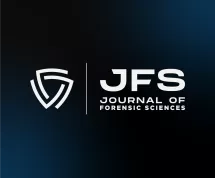Search
Explore content from JFS, ASB, the AAFS Newsfeed, and other content using the search bar or filters.
Method for estimating real‐scale 3D human body shape from an image based on 3D camera...
The combination of computer vision (CV) and computer graphics (CG) is being developed for use in many fields. Consequently, reverse projection photogrammetry, which identifies geometric properties of a subject based on accurate reproduction of the image content, is beginning to r...
Chemical profiling of developmental stages in three major flies via direct infusion mass...
Forensic entomology has become an essential tool for estimating the minimum postmortem interval (mPMI), especially in scenarios where traditional methods are limited. This study aimed to characterize and differentiate the chemical profiles of three major forensically relevant fly...
Decision trees for combining morphological traits and measurements of the skull for...
Forensic anthropologists commonly estimate osteological sex using separate metric and morphological analyses, without integrating both data types into a single statistical model. Combining data types into one classification model has the potential to increase sex classification a...
A preliminary study of the evaluation of breech face impressions produced by various...
During cartridge case comparisons, firearm examiners must distinguish between different markings found on the cartridge cases. These characteristics can be classified into class, subclass, or individual characteristics. There is potential for a false identification if firearm exa...
Psychotherapeutic treatment outcome of a female filicide patient
A case of double filicide of both her children admitted to a forensic psychiatric facility is described. According to the CARE guidelines (for CAse REports), a full description of the patient, clinical and diagnostic scenarios, the crime, psychotherapy treatment, and changes in p...
Seasonal decomposition and the effect of clothing in Cape Town, South Africa
Unidentified, unclaimed human remains are a substantial problem in many developing nations, including South Africa. Most forensic cases in Cape Town involve clothed individuals found in thicketed environments. To assist in local medico‐legal death investigations, we gathered taph...
Issue Information
Examining the effects of 3D printed projectiles on firearm identification
In recent years, 3D printers have become more affordable for the average consumer to purchase, and new printers require less user input, making the process accessible to anyone who can download files online. Due to these factors, these printers are being used to manufacture firea...
The dermestid beetle (Dermestes maculatus) as a biotic taphonomic agent: Further...
The dermestid beetle (Dermestes maculatus) has become renowned in the laboratory as an aid to skeletonization of remains. However, little attention has been paid to the potential effects these insects can have on hard tissues and whether their traces may be mistaken for trauma or...
Lab‐based evaluation of first‐ and second‐generation gamma‐hydroxybutyrate test strips and...
Gamma hydroxybutyrate (GHB) has been used as a drug to facilitate sexual assault. Commercial testing devices are available for bars and patrons to test drinks that may have been spiked with GHB. In this study, six first‐generation GHB test devices were evaluated for the detection...
FSF Bashkinski Grant – July 31 Deadline Reminder
From theory to practice: Protocol adaptations for swift victim identification in the...
The October 7, 2023, massacre in Israel posed unprecedented challenges for disaster victim identification (DVI), requiring adaptations to international forensic protocols to address extreme conditions, including active conflict, fragmented remains, and cultural and religious cons...
Characteristics and toxicology of adult deaths due to quetiapine toxicity in Australia,...
Quetiapine is an atypical antipsychotic that has been associated with both intentional and unintentional deaths. We aimed to determine, stratified by intentionality: (1) The characteristics and circumstances of adult deaths attributed solely to quetiapine toxicity in Australia, 2...
Digital otoscopic examination of tympanic membranes in confirmed suicidal hanging deaths:...
A crucial factor in cases of apparent hanging deaths is establishing whether an antemortem hanging or postmortem suspension has occurred. Hanging diagnosis relies upon the history, scene investigation, and gross examination of the body including the ligature furrow and possible r...
ASB Newsletter – June 27, 2025
Annual Membership Dues
Upcoming NJIT Conferences
